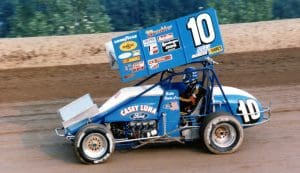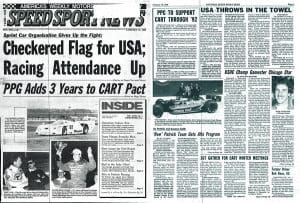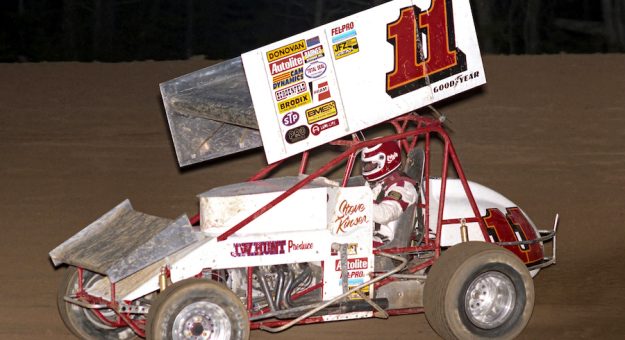The first two paragraphs of the lede story on page three of the Jan. 10, 1990, issue of National Speed Sport News ended an 18-month battle that divided winged sprint car racing into two top-tier series:
DALLAS, Texas — It all began with a barrel full of optimism, grand fireworks displays at the opening shows and great hope for the future of sprint car racing. At its end, the United Sprint Ass’n went out of business with barely a whimper.
The newest major sanctioning organization in the country called it quits last week with its leaders weary from the year-and-a-half battle for supremacy in the national sprint car scene. The formal end came with the resignation of USA President Larry Clark on Jan. 2.
It’s been 35 years since the United Sprint Ass’n challenged the World of Outlaws, and once again winged sprint car racing is a house divided. This time, the rival organization is the High Limit Racing series, whose founders include five-time and reigning Outlaws champion Brad Sweet and 2021 NASCAR Cup Series champion Kyle Larson.
With this latest battle for sprint car supremacy underway, we dug into the SPEED SPORT archives to refresh our memory about the United Sprint Ass’n and the 1989 racing season.
Here’s a portion of what we found:
■ A meeting of disgruntled World of Outlaws car owners was held in Memphis on April 16, 1988, at which 14 leading teams voted unanimously to proceed after talk of a new organization – or maybe a car owners’ union or group – surfaced.
■ Two weeks later, another gathering in Des Moines, Iowa, produced plans for a completely new sprint car organization to be named the United Sprint Ass’n. Larry Clark, a CPA from Des Moines, was chosen to serve as the sanctioning body’s president and to manage its business affairs.
Days later, two prominent World of Outlaws employees, director of competition Beryl Christian and marketing director Gary Carley, announced their resignations and began to set up USA. WoO public relations director Gary Guehler and WoO office manager Dee Dee Martin also resigned and joined the USA team, which was headquartered in Dallas.
■ Stockholder support came from drivers Steve Kinser and Sammy Swindell, and car owners Karl Kinser, Harrold Annett, Max Rogers and Danny Peace. Other stockholders included Iowa businessman Donald Lamberti, Californian Jerry Harbert and Clark.

■ An early indicator of internal issues at USA came when Christian, the organization’s vice president of competition, was either fired or resigned prior to the group’s planned fall 1988 mini-series. SPEED SPORT reported that personal differences between Clark and Christian caused the departure.
■ A three-race USA mini-series was run following the completion of the 1988 WoO season and was a resounding success. Mark Kinser won the Western World Championship at Manzanita Speedway in Phoenix; Dave Blaney went to victory lane at Memphis Motorsports Park in Millington, Tenn., and Doug Wolfgang topped the Winter Nationals at Devil’s Bowl Speedway in Mesquite, Texas.
Steve Kinser went winless but edged teammate Mark Kinser by 12 points to earn the 1988 USA championship. A $100,000 points fund was paid following the three-race series and the future of the new sanctioning body appeared bright.
■ Shortly after the calendar turned to 1989, Guehler boarded a plane for Philadelphia where he revealed the series’ 1989 plans to members of the Eastern Motorsports Press Ass’n. What Guehler unveiled was an impressive $3 million, 47-race schedule.
■ However, just days after the schedule was published in National Speed Sport News, promoters began reporting they had never signed a contract, nor did they intend to sign one, for the dates announced by USA. Some said the schedule was simply a bunch of hot air.
■ Once the USA season opened in March, things went downhill quickly. Bad weather hit the organization hard, wiping out several shows and causing very small crowds at others.
■ Then, Carley was fired. Clark told SPEED SPORT that the marketing veteran had been hired to secure sponsors and no major supporters had been signed. Veteran West Coast racing businessman/promoter David Vodden was soon hired.
■ Despite being applauded by multiple sources in the short-track industry for its creativity, a new race format that financially rewarded competitors for performance and passing was unveiled in April but never implemented. Clark said a pair of USA stockholders preferred to retain the current system, which was a carbon copy of the format used by the World of Outlaws.
■ Guehler was the next staff member to be let go, reportedly for financial reasons, and the organization’s innovative toll-free telephone number where fans could obtain information and race dates was disconnected to reduce expenses.
■ After getting off to a rough start, USA’s schedule increased through the summer and its crowds grew. Among the late-season highlights were a unique doubleheader at Iowa’s Knoxville Raceway, the $51,000-to-win National Open at Selinsgrove (Pa.) Speedway and the Western World Championship at Manzanita Speedway in Phoenix.
Ending the season on a high note, the USA finale attracted an overflow crowd to Lanny Edwards’ historic Devil’s Bowl Speedway in Mesquite, Texas.

■ The smiles quickly disappeared, however, as USA’s issues didn’t end with the final checkered flag of the season. Questions concerning a promised $100,00 points fund along with the absence of a national sponsor and television coverage, all provided by the World of Outlaws, left gaping holes in the professional approach promised by USA.
■ In a bitter five-page press release distributed Jan. 2, 1990, USA President Larry Clark resigned.
His move came after Steve and Karl Kinser informed Clark on Dec. 26 that they were returning to the World of Outlaws fold for the 1990 season, citing the increased WoO points fund and the number of televised races.
“My decision to resign is based not only on the events of the past 48 hours but also the overall lack of commitment and trust provided by the entire racing community,” Clark said in his statement.
“The personal sacrifice is too great when you consider how easy it has been for so many people who have openly condemned the state of sprint car racing today, to endorse the very same program that created the need for our existence.”
■ Left in the wake of USA’s demise were race tracks that did not pursue 1990 WoO dates. Among the most notable were USA’s marquee venues, Selinsgrove (Pa.) Speedway, Manzanita Speedway and Devil’s Bowl Speedway.
■ Looking back, it should be noted that all of the drivers who finished among the top 10 in the final United Sprint Ass’n points for 1989 have since been inducted into the National Sprint Car Hall of Fame.
■ Soon after USA was formed, a World of Outlaws driver told SPEED SPORT, “One result of this split is that it’s gotten Ted (Johnson) off his ass.”
WoO founder Ted Johnson had fallen into the status quo. But with the formation of a competing series, he quickly sprang back to life and began working on new sponsors, new programs and other various ways to improve his series.
■ By the end of 1989, Johnson had hosted the World of Outlaws awards banquet, paid the complete points fund and released the series’ 1990 schedule.
As of New Year’s Day, USA had completed none of the above.
